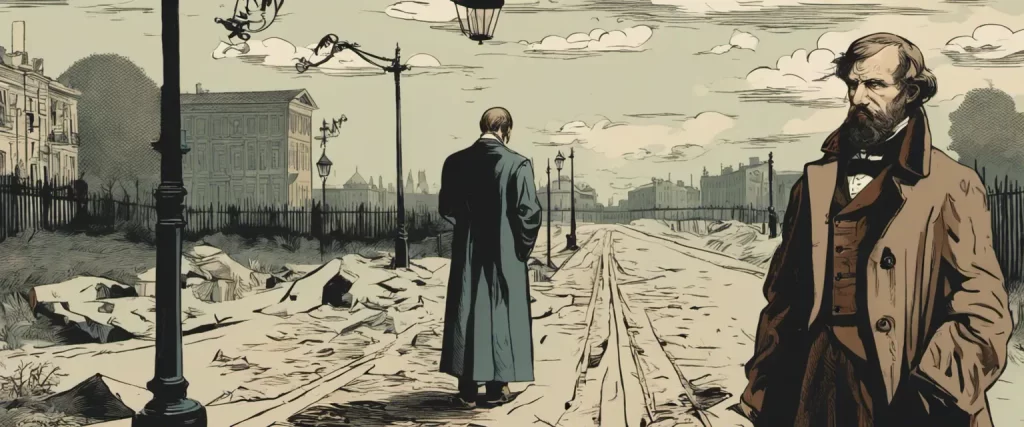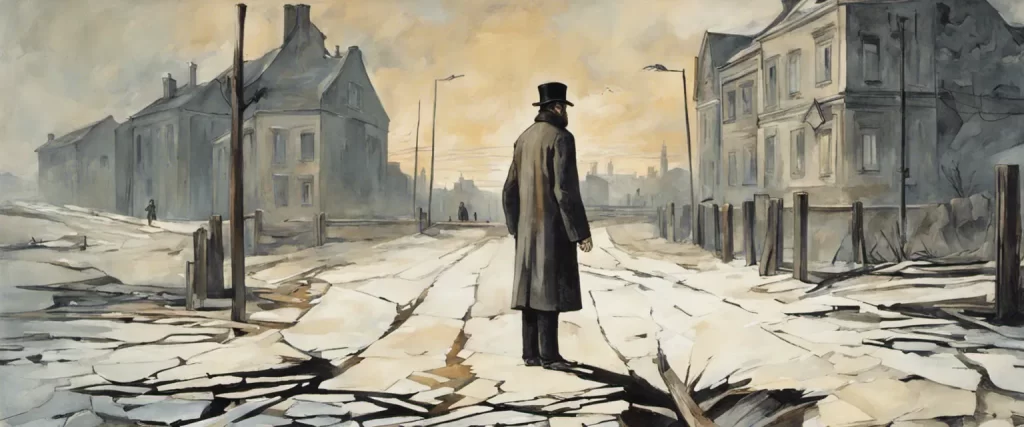
What is so great about Crime and Punishment?
Crime and Punishment, written by Fyodor Dostoevsky, is often celebrated as one of the greatest novels in world literature. Here are some reasons why it is considered so great:
1. Complex C haracters: The novel is known for its deep and complex characters, particularly the protagonist Raskolnikov. Dostoevsky explores the psyche of his characters, delving into their motivations, inner conflicts, and moral dilemmas. Raskolnikov’s internal struggle with his own morality and his descent into madness captivates readers.
2. Psychological Depth: Crime and Punishment delves into the complexities of the human mind, exploring themes of guilt, redemption, and the consequences of one’s actions. Dostoevsky masterfully explores the psychological and emotional turmoil experienced by his characters, offering profound insights into human nature.
3. Social Criticism: The novel critiques the socio-political landscape of 19th-century Russia, addressing issues such as poverty, inequality, and the struggle for justice. Dostoevsky weaves in social commentary through vivid descriptions of the society and its various characters, shedding light on the harsh realities faced by people living in that era.
4. Philosophical Exploration: Crime and Punishment explores existential and philosophical questions. Dostoevsky delves into themes of morality, free will, the nature of evil, and the role of suffering in human life. The novel raises thought-provoking questions about the nature of crime, punishment, and the human condition.
5. Narrative Technique: Dostoevsky’s narrative technique is both engaging and immersive. The novel incorporates suspense, a fast-paced plot, and unexpected twists, keeping readers on the edge of their seats. Dostoevsky’s skillful use of language and dialogue adds intensity and depth to the story.
6. Timeless Relevance: Despite being written in the 19th century, Crime and Punishment’s exploration of moral and ethical dilemmas remains highly relevant today. Its themes of individual responsibility, redemption, and the search for meaning in life resonate with contemporary readers.
Overall, Crime and Punishment stands out for its profound psychological insights, thought-provoking themes, and its ability to captivate readers with a masterfully crafted narrative. Its lasting impact on literature and its enduring popularity make it a novel held in high esteem by many.
Why did Fyodor write Crime and punishment?
Fyodor Dostoevsky wrote Crime and Punishment to explore complex ethical and psychological themes related to morality, guilt, redemption, and the consequences of committing a crime. The novel delves into the inner workings of the human mind, particularly the psyche of its protagonist, Raskolnikov. Dostoevsky was interested in exploring the fine line between good and evil, and how immoral actions can have profound psychological effects on individuals. Through the story, he also wanted to critique the rationalistic and utilitarian ideologies that were prevalent in 19th-century Russia. Ultimately, Dostoevsky aimed to present a realistic portrayal of the human condition and the moral dilemmas faced by individuals in a society plagued by poverty, social unrest, and moral decay.
Is Crime and punishment an easy read?
No, Crime and Punishment by Fyodor Dostoevsky is not considered an easy read. It is a challenging and complex novel, both in terms of its philosophical themes and its dense prose. The book delves into the psyche of its protagonist, Raskolnikov, and explores existential and moral dilemmas. It requires careful attention and reflection to fully appreciate and understand.

How old is Raskolnikov in Crime and Punishment?
Raskolnikov, the main protagonist in Fyodor Dostoevsky’s novel “Crime and Punishment,” is portrayed as a young man in his early twenties.
What crime did Dostoevsky commit?
Fyodor Dostoevsky was convicted of political crimes. In 1849, he was arrested for being a part of the Petrashevsky Circle, a group of intellectuals who held discussions criticizing the government and advocating for social reform. Dostoevsky and his fellow circle members were charged with inciting rebellion against the Tsarist regime and were sentenced to death by firing squad. However, just moments before the execution, their sentences were commuted to hard labor in Siberia.
Who is Ivan Karamazov in Crime and punishment?
Ivan Karamazov is not a character in Crime and Punishment, but rather in another famous Russian novel called The Brothers Karamazov, written by Fyodor Dostoevsky. In The Brothers Karamazov, Ivan Karamazov is one of the main characters and the eldest son of Fyodor Karamazov. He is known for his intellectual and philosophical nature, often engaging in debates about God, morality, and the existence of evil. Ivan is portrayed as a complex character struggling with his own inner demons and moral dilemmas, eventually culminating in a mental breakdown.
What is the gist of Crime and Punishment?
The gist of Crime and Punishment revolves around the story of Rodion Raskolnikov, a poor ex-student in St. Petersburg, Russia. Raskolnikov, an intelligent and ambitious young man, becomes consumed by an extraordinary theory that, in exceptional cases, individuals with great intellect and purpose are justified in committing crimes for the greater good of society. To test this theory, he plans and executes the murder of a pawnbroker, Alyona Ivanovna. After the crime, Raskolnikov experiences waves of guilt, paranoia, and psychological torture, struggling to come to terms with his actions. As the story unfolds, Raskolnikov’s inner turmoil is contrasted with the lives of other characters, including his sister, mother, and two love interests, Sonya and Dunya. The novel delves into themes of morality, redemption, and the consequences of one’s actions, ultimately leading Raskolnikov to seek redemption and change his perspective, accepting punishment as a path to salvation.

What is the meaning of title in crime and punishment?
The title “Crime and Punishment” refers to the two major themes explored in Fyodor Dostoevsky’s novel.
Crime refers to the act committed by the main protagonist, Raskolnikov, who murders an old pawnbroker and her sister. The novel delves into the psychological and moral consequences of this crime, as well as Raskolnikov’s internal struggle with guilt, remorse, and paranoia.
Punishment, on the other hand, represents the various forms of punishment experienced by Raskolnikov and other characters in the story. Beyond the legal consequences he faces, Raskolnikov is tormented by his own conscience, leading to internal punishment. He also faces judgment and punishment from others in his community, including suspicion and scrutiny from police, family, and friends.
Overall, the title “Crime and Punishment” highlights the exploration of the consequences of crime and the various forms of punishment, both external and internal, throughout the narrative.
How is afterlife personified in Crime and Punishment?
In Fyodor Dostoevsky’s Crime and Punishment, the concept of the afterlife is personified through the character of Sonia Marmeladova. Sonia serves as a representation of religious faith and redemption in the novel, offering a glimpse into the possibility of afterlife and redemption for the protagonist, Raskolnikov.
Sonia, a young prostitute, is depicted as a selfless and morally virtuous character, deeply devoted to her faith. She frequently quotes biblical passages and holds onto her belief in God as a source of solace and hope. Through her interactions with Raskolnikov, Sonia becomes a catalyst for his redemption and a symbol of the possibility of spiritual salvation after committing heinous crimes.
Sonia’s unwavering faith and forgiveness help fuel Raskolnikov’s realization of his own guilt and the need for redemption. Her presence in the novel represents the existence of a higher power, an afterlife where sins can be forgiven and souls can be redeemed. Sonia’s offer of love and forgiveness serves as a powerful reminder to Raskolnikov that he can find salvation, even after committing a terrible crime.
Additionally, Dostoevsky portrays Sonia’s suffering as a parallel to the concept of purgatory or a form of punishment. She endures the hardships of her profession and willingly sacrifices herself to support her family. Through her struggles, Sonia personifies the notion that earthly suffering can lead to spiritual growth and eventual redemption in the afterlife.
Overall, Sonia Marmeladova personifies the afterlife in Crime and Punishment, offering hope, redemption, and the possibility of salvation for Raskolnikov. She represents the power of faith, forgiveness, and the potential for transformation even after committing heinous acts.
Book Recommendation for the people who loved Crime and Punishment by Fyodor Dostoevsky
If you loved Crime and Punishment by Fyodor Dostoevsky and Fahrenheit 451 by Ray Bradbury, I would recommend the following book:
1. The Trial by Franz Kafka – This novel explores themes of guilt, justice, and the absurdity of bureaucracy, similar to Crime and Punishment. It follows the story of a man who is arrested and prosecuted by an elusive and inaccessible court system.
Other recommendations for fans of Crime and Punishment, excluding books by Fyodor Dostoevsky:
2. The Stranger by Albert Camus – This existentialist novel deals with the themes of morality, alienation, and the absurdity of human existence. It follows the story of a man who commits a crime and struggles to find meaning in life.
3. The Master and Margarita by Mikhail Bulgakov – This satirical and philosophical novel combines elements of fantasy, comedy, and tragedy. It explores themes of good and evil, religious and political corruption, and the power of art.
4. The Picture of Dorian Gray by Oscar Wilde – This novel delves into the themes of morality, sin, and the dual nature of human existence. It follows the story of a man who remains eternally young while a portrait of him reflects his moral degradation.
5. One Hundred Years of Solitude by Gabriel Garcia Marquez – This magical realism novel chronicles the lives of the Buendía family across several generations. It explores themes of past sins, the cyclical nature of time, and the complexities of human relationships.
These recommendations should provide you with compelling stories that explore similar themes and ideas as Crime and Punishment.

5 thoughts on “Crime and Punishment Exposed: 10 Burning Questions Answered”